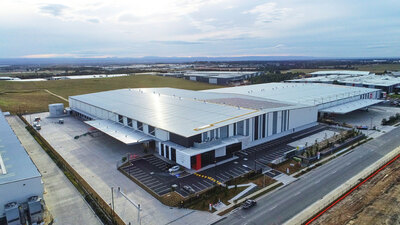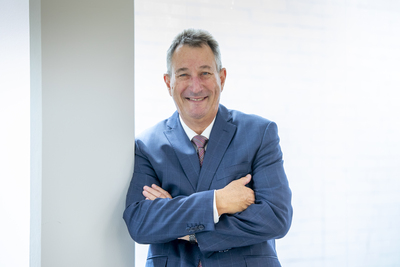Keeping the green in greenfield

In the wake of the 2021 United Nations Climate Change Conference and alongside the federal government’s 2050 net zero target, industry leaders are pledging to reduce the Australian construction sector’s environmental impact during 2022.
While efforts to tackle climate change will be distributed across many facets of the sector, there will be a strong focus on one rapidly growing area: industrial construction.
Australian owned and operated construction company Hansen Yuncken saw a 150% year-on-year increase in industrial workload during 2021 — largely due to COVID’s ‘online shopping boom’ which accelerated the growth of industries like e-commerce and logistics.
This sudden increase in industrial projects creates major opportunities for the Australian construction sector to evolve to more sustainable and forward-thinking developments, said Hansen Yuncken CEO Peter Salveson.
“The majority of projects delivered by Hansen Yuncken have been distribution centres, specialised storage warehouses, temperature-controlled facilities, manufacturing alongside a number of speculative projects for future tenants,” Salveson said.
“COVID has certainly influenced clients to think differently in respect to design and user experience of our facilities. We work collaboratively with developers and clients to adopt innovative systems and processes to help facilitate industry-wide use of emerging technologies such as online communication and inspections, design portals and quality management.
“While there hasn’t been a dramatic change in the look of these buildings, we have observed a very noticeable shift toward more sustainable work practices and environments. Workplaces are changing to make the workplace a better place to be.”
An example of Hansen Yuncken projects placing the spotlight on sustainability is the 17,965 m2 Frasers Williams-Sonoma Logistics Facility in NSW, completed in 2021. The project targeted a 5-Star Green Star rating, which is becoming more common for industrial facilities, highlighting the importance of sustainability to the future of the sector.

Yuncken also partnered with Frasers in Melbourne to deliver the 6-Star Green Star rated facility for Ceva in Truganina. The facility consists of a 30,000 m2 warehouse for Ceva parts and stock, as well as a feature office. This facility was designed to incorporate solar generation, water re-use and minimisation, energy monitoring and minimisation, interior comfort increased through thermal comfort, efficient commissioning and material selectivity.
Another example is Queensland’s state-of-the-art 25,000 m2 HFA Heathwood Meat Processing Facility, constructed in response to the shift towards online food delivery. The development features what is claimed to be Australia’s second largest rooftop photovoltaic solar installation, providing approximately 50% of the site’s energy requirements.

“The inclusion of solar installation across industrial sites played a huge part in Australia meeting its 2020 Renewable Energy Target, which was to ensure at least 33,000 gigawatt-hours (GWh) of Australia’s electricity comes from renewable sources, a year ahead of schedule,” Salveson explained.
“The larger end of the two-pronged target required high-energy users to acquire a certain proportion of energy from renewable sources. Ensuring industrial developments have renewable sources of energy is integral in Australia’s move toward a greener future.”
Another innovation by Hansen Yuncken to reduce environmental impact is the onsite waste recycling centre implemented at Victoria’s 80,000 m2 Secon Freight Logistics site. The centre was used by all trades involved in the project to discard various metal bins, timber, plasterboard and general waste.

“Not only did this initiative reduce time and costs for the client, the project saw a significant reduction in materials sent to landfill and should be viewed as a model for projects of this scale nationwide,” Salveson said.
“These projects represent our diversely talented project team and innovative methodologies blended with efficiencies and our focus on supporting key issues including sustainability.
“In addition to protecting our environment, there has also been a strong focus on pandemic-resilient design, particularly among new industrial projects. We have also seen growing demand for the inclusion of provisions and amenities to better promote work/life balance, such as fitness and childcare facilities, cafes and eateries. Creating a ‘sense of place’ for staff has become more important as a result of the pandemic.”
Salveson says industrial projects will continue to play a significant role in sustainable development, as they utilise their potential for solar energy generation and rainwater collection and re-use, as well as ensuring minimal energy usage throughout operations.
In terms of sector growth, Salveson said: “We are seeing high demand for projects ranging from 15,000 to 80,000 m2. There is a steady, strong pipeline of industrial projects with facilities ever increasing in size and complexity.
“Over the past five to 10 years, large industrial precincts have emerged in the western suburbs of Sydney due to the proximity of transport networks, both existing and developing. However, looking forward, these facilities are to be located across the outer metropolitan areas of Sydney and Melbourne.
“Even as pandemic restrictions ease, we expect the demand for industrial facilities to continue to rise: people have turned to online shopping, to name one industry as an example, and they aren’t turning back.
“Our job is to ensure this rise in demand is married with a continued focus on environmentally sustainable practice. Protecting our planet is always front of mind, and we look to deliver that in every project we undertake.”

Hansen Yuncken has delivered more than 150 industrial projects worth $2.6 billion and will continue to champion sustainability in this sector.
How to navigate Australia’s new climate regulations
Australia’s new mandatory climate reporting regulations are set to take effect next year,...
A concrete use for carpet fibres
Australian engineers have come up with an unexpected use for discarded carpets: as a means to...
COP29: finance, a "crucial" opportunity and a seat at the table
Leaders and diplomats from around the world are descending on Baku, Azerbaijan, this month for...









